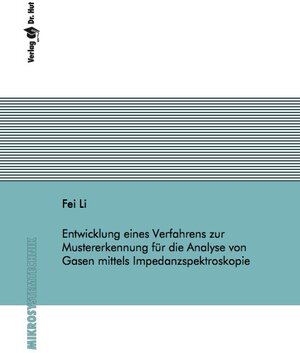
×
![Buchcover ISBN 9783843938990]()
Entwicklung eines Verfahrens zur Mustererkennung für die Analyse von Gasen mittels Impedanzspektroskopie
von Fei LiThe purpose of this work is to find out a pattern recognition method, which is suitable for gas sensors based on impedance spectroscopy.
For large amount of data, the pattern recognition method is a combination of feature reduction and classification methods. In this work, a novel feature reduction method, adaptive-simulated-annealing-supported-parameter-estimation (ASA-PE), and a Classifier, committee-machine (CM) are developed, which can realize automatic detection of the concentrations of different gases.
In the experiment a homemade conducting poly (3, 4-ethylene-dioxythiophene) (PEDOT) film is used as sensor. With help of impedance spectroscopy different concentration of ammonia (NH3) and nitrogen dioxide (NO2) gases (carrier gas is nitrogen gas) are tested. The results of measurements are used for test of the combinations of several feature reduction methods and classifiers.
The results of ASA-PE are compared with those from complex-principle-component-analysis (CPCA) and discriminant-analysis-via-support-vector (SVDA). It revealed that all used algorithms are satisfied. However, the ASA-PE can ensure a minimal loss of information and the results of ASA-PE can be used for further gas analysis.
The distance-weighted-k-nearest-neighbor (DW-kNN), multiple-layer-perceptron (MLP), support-vector-machine (SVM) and CM are used as classifier for the extracted features. All combinations of the above-mentioned feature reduction methods and classifiers have been compared with each other.
If the number of training set is large enough and both concentration and gas are trained, the results of gas recognition from all combinations are satisfying.
In the situation of a low number of training samples, but concentration or gas are both educated, ASA-PE with SVM showed the best result.
However, the combination of the CPCA with CM showed the best performance, if the test gas or test gas concentration is not trained.
For large amount of data, the pattern recognition method is a combination of feature reduction and classification methods. In this work, a novel feature reduction method, adaptive-simulated-annealing-supported-parameter-estimation (ASA-PE), and a Classifier, committee-machine (CM) are developed, which can realize automatic detection of the concentrations of different gases.
In the experiment a homemade conducting poly (3, 4-ethylene-dioxythiophene) (PEDOT) film is used as sensor. With help of impedance spectroscopy different concentration of ammonia (NH3) and nitrogen dioxide (NO2) gases (carrier gas is nitrogen gas) are tested. The results of measurements are used for test of the combinations of several feature reduction methods and classifiers.
The results of ASA-PE are compared with those from complex-principle-component-analysis (CPCA) and discriminant-analysis-via-support-vector (SVDA). It revealed that all used algorithms are satisfied. However, the ASA-PE can ensure a minimal loss of information and the results of ASA-PE can be used for further gas analysis.
The distance-weighted-k-nearest-neighbor (DW-kNN), multiple-layer-perceptron (MLP), support-vector-machine (SVM) and CM are used as classifier for the extracted features. All combinations of the above-mentioned feature reduction methods and classifiers have been compared with each other.
If the number of training set is large enough and both concentration and gas are trained, the results of gas recognition from all combinations are satisfying.
In the situation of a low number of training samples, but concentration or gas are both educated, ASA-PE with SVM showed the best result.
However, the combination of the CPCA with CM showed the best performance, if the test gas or test gas concentration is not trained.


